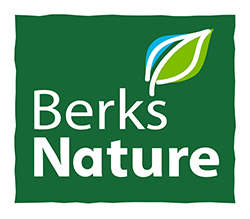The Nature Place has been buzzing this summer, and it’s not just the fervent activity of our Eco-Campers!
In the welcome space of The Nature Place, Berks Nature maintains an observation beehive: a living, active hive cased in glass (with an egress, of course, allowing the bees to come and go). The buzzing hum from these tiniest members of our Berks Nature team is cause for celebration: our original hive perished in the spring of 2023, after five successful years, and establishing a new colony has not been without its challenges.
Over this summer, Berks Nature’s hive swarmed at least three times, an indicator of the colony’s health and size.
Swarming occurs when a honeybee colony outgrows its home and results in creation of a new colony! As space in the hive gets cramped, worker bees create new queen “cells” in which baby queen bees can grow and develop. Ultimately, the original queen will leave the hive, followed by a reverberating cloud of worker bees (the “swarm”). Half of the hive’s workforce will follow the original queen to build a new colony, while the remaining worker bees will stay behind to live in fealty under the new queen.

Honeybees swarming at the egress of The Nature Place’s observation bee hive in April 2025.

Queen #1 – the ruling queen at the start of spring 2025.

Queen #2 – the queen that took over after the first swarm in mid-summer 2025.

Queen #3 – the current ruling queen of Berks Nature’s observation hive.
As thousands of buzzing bees circled The Nature Place’s pollinator garden in one of nature’s most dazzling displays of coordination, Berks Nature didn’t call an exterminator, we called Bruce.
Bruce Rodriguez is a passionate beekeeper who focuses on Treatment-Free Beekeeping, gardening, and bee rescues. That’s right. Bruce gets calls from across the area when people find honeybee colonies in their homes, trees, and elsewhere. He collects and rehomes these bees.
Are Bee Swarms Dangerous?
Bee swarms may look intimidating, but so long as you don’t bother the bees, they won’t bother you. In fact, swarming bees are less aggressive! Those defensive, stinging tendencies of honeybees arise from a bee’s urge to protect its hive (and the young bees brooding inside). But swarming bees have no hive to protect.
Berks Nature’s current observation hive is one of Bruce’s rehomed bee colonies. So, when these bees swarmed, we called in Bruce for a little reunion.
The life of a bee rescuer may sound frenetic, trying to collect and contain crowds of winged, stinging insects, but Bruce’s approach lets the bees take the lead.
“I put them in a suitable box and let them do what bees do—build combs and gather their own food,” he explained.
Other beekeepers are more controlling and will even use chemicals like pesticides to manage their hives. Not Bruce.
“Beekeeping is a choice,” he said. “Do you want to help bees thrive, or just treat them as livestock for honey? If it’s just honey you want, go buy it at the store—it’s easier, cheaper, and better for the bees.”
Sweet as Honey
Many visitors ask if we collect honey from our observation hive. We do not, for two reasons: First, we want to ensure the bees have plenty of honey for winter. Second, collecting honey would require removing the hive from the wall, which is disruptive. However, we do sell local raw honey from Griesemer Beekeeping, a trusted local consultant.

Bruce Rodriguez of Swarmstead Bees and Garden.
Like all things in nature, honeybees face threats.
The use of pesticides and herbicides damages their food sources, habitat, and health. Our American preference for manicured lawns reduces native plants that provide essential nourishment. Plus, the ever-imposing threat of climate change also poses challenges by shifting flower bloom times and reducing food availability, making it harder for bees to find enough to eat. Malnourished bees are more susceptible to diseases and hive parasites, like Varroa mites and wax moths.
Still, it’s a common misconception that honeybees are “endangered”.
“There are more honeybees today than ever, with over 100 million colonies worldwide,” explains Bruce, “If you want to ‘Save the Bees’, focus on bumblebees and solitary bees, not honeybees.”

English Dawson, Educator and Community Engagement Specialist for Berks Nature, saying hello to one of The Nature Place’s resident honeybees.
Support Your Local Bees!
Pennsylvania is home to at least 437 species of bees including bumblebees, sweat bees, and even leafcutter bees! But we haven’t’ seen 13% of these bee species in the last 8 years, which is concerning, and four species of our beloved bumblebees are either threatened or declining!
The easiest way to help local bees is to plant native flowers! Popular choices include Coneflowers (Echinacea), Milkweed (Asclepias), and Bee Balm (Monarda), all of which you can find growing at The Nature Place.
If you’d like to support The Nature Place’s honeybee colony, consider adopting a bee through our store! Your “adoption fee” will go directly to planting and maintaining native flower gardens. In return, you’ll receive a crocheted keychain (made by Birchtree Creations), a certificate of adoption, and the satisfaction of helping feed the bees.

